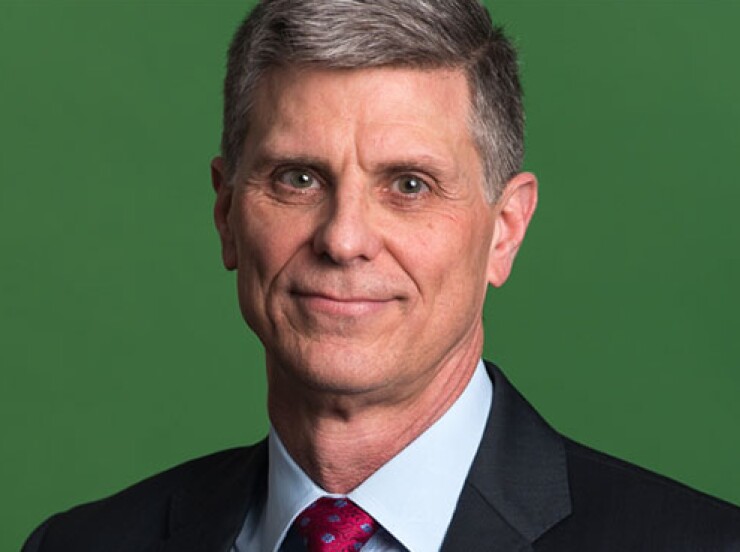Even though interest rates have not risen as fast as the bond insurance industry hoped for, and 2017 saw the contraction of an active insurer, the bond insurance wrap remains relatively stable in terms of market share.
For the past few years, the bond insurance industry has been made up of three players: Assured Guaranty Corp., Build America Mutual and National Public Guarantee Corp. That changed in June, when S&P Global Ratings handed a two-notch downgrade to National, which caused the muni-only arm of MBIA Inc. to curtail its new business and lay off 29 employees. A month prior to the downgrade, S&P placed both National and BAM on credit watch negative, but later affirmed BAM's rating at AA stable.
The municipal bond insurance penetration rate dropped to 5.29% for 2017, from 5.70% in 2016. Assured, Build America Mutual, and National Public Finance Guarantee wrapped a total of $23.06 billion in 1,833 issues, down from $25.33 billion in 1,889 transactions during the prior year.
Even though the market is far less than the 50% insured it was back before the financial crisis, bond insurance is still an important part of the industry, with a lot of eyes on it. One example being Hartford, Conn., which has had its share of financial troubles and was downgraded deep into junk territory by the rating agencies after the mayor and other city officials publicly stated that a Chapter 9 bankruptcy filing was a possibility. Bond insurance guaranteed approximately two thirds of the city’s outstanding debt, and got involved to demonstrate to the city and state that they should consider alternatives to a bankruptcy filing – especially because a Chapter 9 case in the state capital would likely have negative impacts on the market for bond sales by other Connecticut cities. Today, Hartford appears on the road to a successful resolution that will avoid losses for both insured and uninsured holders of the bonds, and investors have a new case study highlighting the value of having the insurers in place to intervene before a distressed situation becomes a crisis.
Assured insured $13.46 billion of par value in 832 transactions as its share of the insured market rose to 58.3% from 56.1% in 2016, according to data from Thomson Reuters. Assured's insured par in 2017 was less than the $14.23 billion in 904 deals during the same time the year before. The figures include Assured's subsidiary Municipal Assurance Corp.
“Assured Guaranty led the market in terms of both par and the number of transactions insured during 2017, capturing 58% of the par volume sold with insurance,” said Robert Tucker, senior managing director of communications and investor relations for Assured. “Our total 2017 insured par in both primary and secondary markets was $15.2 billion. Our $13.5 billion of new issue par from 833 transactions exceeded the insured par of our closest competitor by 50%, and was approximately $4 billion more than the combined total for the rest of the industry. Additionally, it was another strong year for Assured Guaranty in the secondary market, where we achieved $1.7 billion of par insured.”

This year, ratings of AGM and MAC were affirmed by S&P at AA and KBRA at AA+ with stable outlooks, once again demonstrating Assured Guaranty’s strong financial position.
“Growing institutional investor appreciation of our balance sheet strength, underwriting capabilities, diversified business strategy and trading value was reflected in the 62 transactions issued in 2017 with $50 million or more of our insurance, for a total of $6 billion of par,” said Tucker. “Further, we provided insurance on approximately $1.5 billion par of double-A quality issues.”
Tucker said that the muni market has consistently chosen Assured as the preferred insurer based its financial strength, disciplined underwriting, the trading value and market liquidity of our insured bonds, the capital-generating power of our proven business model and our track record of profitability.
“Our group claims-paying resources continued to exceed $12 billion as of September 30, 2017, even as we kept investors whole through timely claim payments, and our capital position further strengthened as our insured leverage ratios declined,” Tucker said.
BAM's insured principal amount dipped to $8.995 billion across 732 deals or 39% market share, from $10.13 billion or 40% market share the same time the year before.
“December was a busy month – we closed 93 new-issue transactions, which was a new record – but it was the capstone to a solid year all around for BAM and the bond insurance industry as a whole, as we continued to expand demand for insured bonds,” said Scott Richbourg, head of public finance, BAM. “Looking at the insurable core of the market – deals rated from BBB-minus to AA-minus – penetration increased and pricing improved on both a total and a risk-adjusted basis, which allowed BAM to grow our claims-paying resources by a record amount even as total new-issue volume declined.”
He also said that S&P’s decision to affirm BAM’s rating after its review reinforced investor confidence in the durability of BAM’s rating, “which has been a key component of our approach to the business all along, and the second half of the year was a return to business as usual.”
National finished the year with $626.6 million of par insurance, down from $969.8 million in 2016. Its market share dropped to 2.7% from 3.8%.





